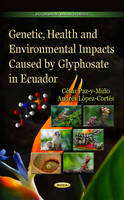Genetic, Health & Environmental Impacts Caused by Glyphosate in EcuadorAuthor :
Hardback
Published : Monday 1 September 2014
You may also like ...

by
Hardback
01 Sep 2014
>>
€177.12
Extended stock - Dispatch 5-7 days
Description
Glyphosate is one of the most widely used chemical products worldwide and its manufacturer has considered it the safest herbicide for human health around the world under the stated technical conditions: a direct fumigation on weed, concentration use of between 1 to 3%, and low dose and low exposure time on the part of the person who is handling the herbicide. Glyphosate has a short lifespan, about three months, but the analyses on the environmental destination of this herbicide get to detect it up to two years later, especially in soils rich in iron. Whatever the case may be, it is obvious that the aerial spraying caused problems in the border, which were studied by several organisations. After being aware of this situation, the Biomedical Research Institute at the Universidad de las Americas outlined a project that was approved by the National Science and Technology Secretariat (Secretaria Nacional de Ciencia y Tecnologia-SENACYT), currently known as the National Higher Education, Science, Technology, and Innovation Secretariat (Secretaria Nacional de Educacion Superior, Ciencia, Tecnologia e Innovacion-SENESCYT), in order to evaluate the impact of the aerial spraying with glyphosate on the Northern border, and to analyze for two years an array of genetic, physical, and psychological factors that define the results that this book gathers. By means of this new book that includes many actors and researchers, we intend to provide scientific information related to the pollution, precaution, protection, and remediation mechanisms, as well as the potential effects caused by the indirect and direct aerial spraying on the Ecuadorian communities settled along the border with Colombia. For a better understanding of the impact caused by the herbicide cocktail, the SENACYT created the Ecotoxicology Network made up of the Universidad de las Americas, the Ecuadorian Natural Sciences Museum, and the Escuela Politecnica Nacional, which focuses on exchanging information that these four institutions will obtain regarding the same topic: aerial spraying with herbicide cocktail and its effects on the Ecuadorian territory.
Reviews